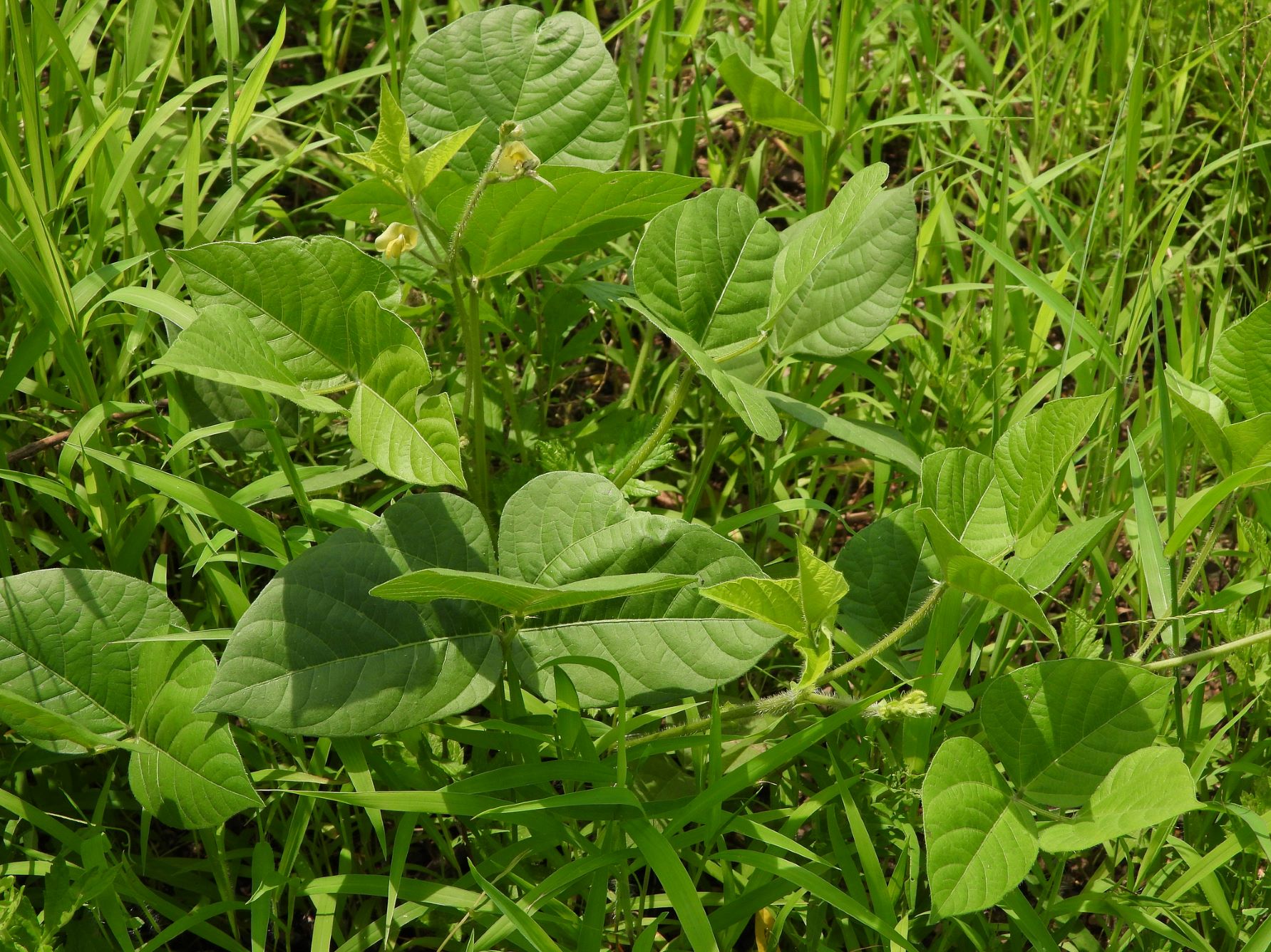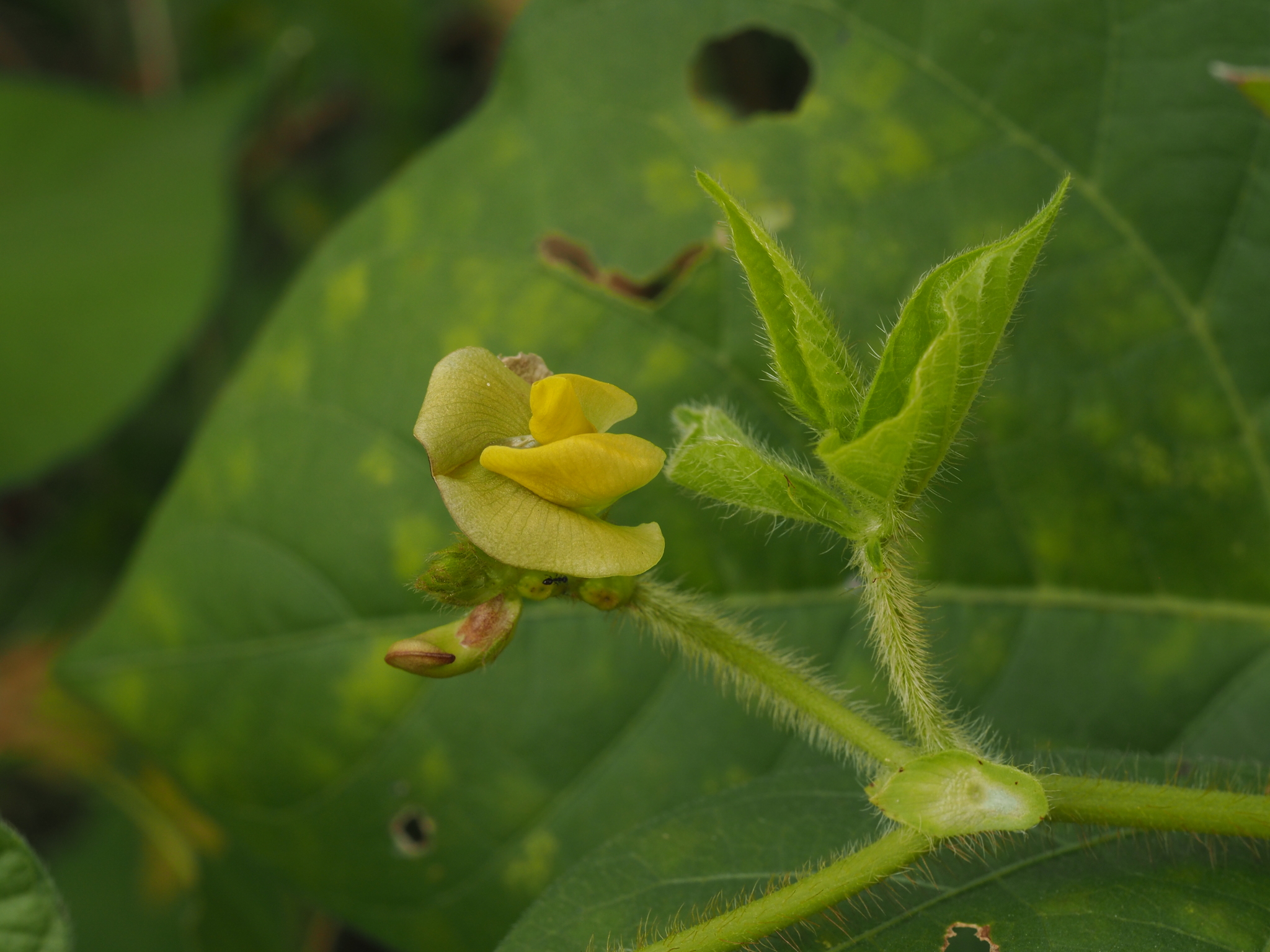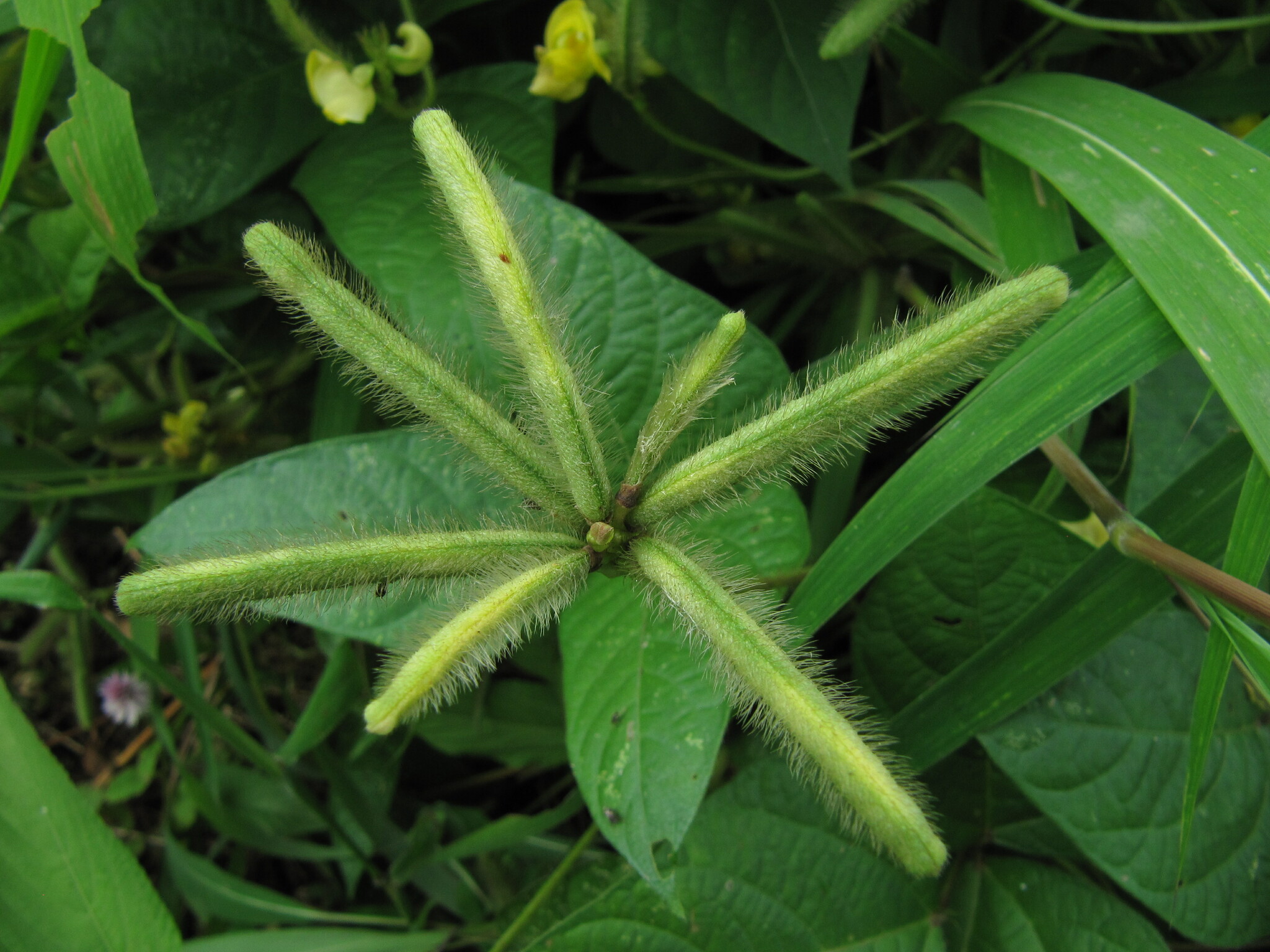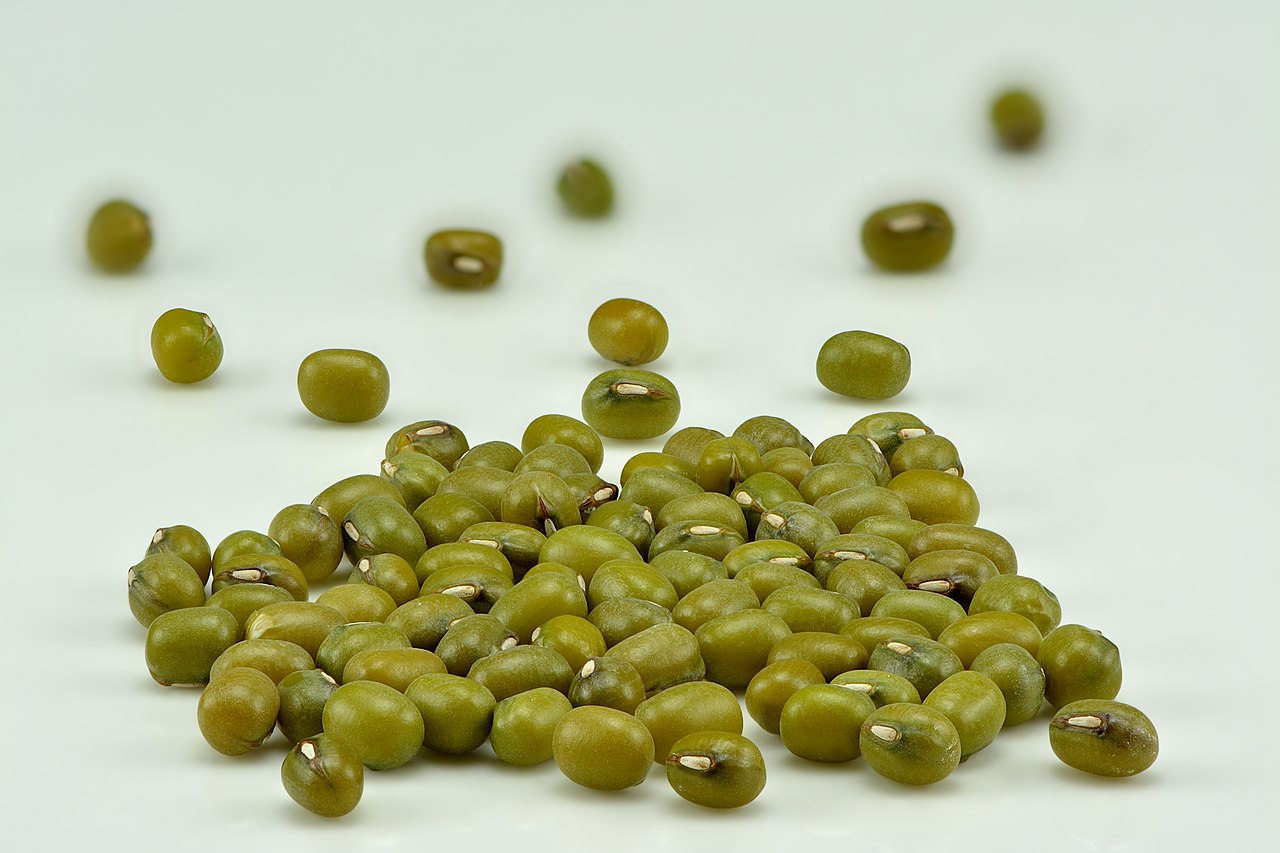ເລກລຳດັບທີ: 745
ລະດັບການຮວບຮວມຂໍ້ມູນ: ຂໍ້ມູນລະອຽດ
ປັບປູງຄັ້ງລ່າສຸດ: 2024-05-01
ຖົ່ວຂຽວ
Mung Bean
Vigna radiata (L.) R.Wilczek
ພືດ
ພືດລົ້ມລຸກ
ຫຍ້າ ແລະ ທັນຍາພືດ
×
ຊື່ທ້ອງຖີ່ນ:
ຖົ່ວຂຽວໄທ: ຖົ່ວຂຽວ, ຖົ່ວຈີມ ( celera-bean, green-gram, mungo-bean, Green Gam and Jerusalem Pea)
ຊື່ພ້ອງ
:
Vigna radiata var. dublobata (Roxb.) Verdc. [Spelling variant]
Vigna radiata var. glabra (Roxb.) Verdc.
Vigna radiata var. grandiflora (Prain) Niyomdham
Vigna radiata var. radiata
Vigna radiata var. setulosa (Dalzell) Ohwi & Ohashi
Vigna radiata var. sublobata (Roxb.) Verdc.
Vigna radiata var. glabra (Roxb.) Verdc.
Vigna radiata var. grandiflora (Prain) Niyomdham
Vigna radiata var. radiata
Vigna radiata var. setulosa (Dalzell) Ohwi & Ohashi
Vigna radiata var. sublobata (Roxb.) Verdc.
ຊື່ສະກຸນ:
Fabaceae
ຊະນິດໃກ້ຄຽງ:
ໝາກຖົ່ວຝັກຍາວ / Yardlong bean
ຖົ່ວແຂກ/ Common bean
ຖົ່ວດຳ/ Black gram
ຖົ່ວແຂກ/ Common bean
ຖົ່ວດຳ/ Black gram
ບັນຍາຍລັກສະນະທາງພືດສາດ:
ຖົ່ວຂຽວເປັນພືດລົ້ມລຸກ, ມີອາຍຸຢູ່ໄດ້ພຽງ 1 ປີ ແລະ ມີລຳຕົ້ນທີ່ບໍ່ມີເນື້ອໄມ້, ລຳຕົ້ນຕັ້ງຊື່ ຄ້າຍໄມ້ຟຸ່ມຂະຫນາດນ້ອຍ ແລະ ສາມາດສູງເຖິງ 30 ຫາ 120 ຊັງຕີແມັດ, ລຳຕົ້ນແຕກກິ່ງກ້ານຢູ່ບໍລິເວນໂຄນ ແລະ ກາງ. ໃນບາງຊະນິດ ມີລໍາຕົ້ນ ເລືອ ຫຼື ເຄິ່ງເລືອໄປຕາມໜ້າດິນ. ລຳຕົ້ນຢູ່ເໜືອໃບເປັນຮູບສີ່ຫຼ່ຽມຈະຕຸລັດ ແລະ ປົກຄຸມດ້ວຍຂົນອ່ອນໆນຸ້ມ.
ໃບຖົ່ວຂຽວຄູ່ທຳອິດເປັນໃບດ່ຽວ ແລະ ອອກຮຽງກົງກັນຂ້າມກັນ, ໃບຕໍ່ໆໄປເປັນໃບປະສົມ, ມີໃບຍ່ອຍສາມໃບຈັດລຽງສະຫຼັບກັນຢູ່ເທິງກ້ານໃບ. ໃບຍ່ອຍເປັນຮູບຮີ ຫຼື ຮູບໄຂ່, ສາມາດຍາວ 5 ຫາ 18 ຊັງຕີແມັດ, ກວ້າງ 4 ຫາ 15 ຊັງຕີແມັດ, ແຜ່ນໃບມັນມີຂົນ ແລະ ມີກ້ານໃບສັ້ນ. ໃບຍ່ອຍໃບກາງມີຫູໃບ 2 ອັນ ແລະ ໃບຍ່ອຍດ້ານຂ້າງມີຫູໃບ 1 ອັນ ຢູ່ດ້ານຂ້າງ.
ອອກດອກເປັນຊໍ່, ອາດມີຄວາມຍາວຮອດ 20 ຊມ, ດອກຍ່ອຍປະກອບມີ 2-25 ດອກ. ກີບມີ 5 ກີບ, ສີເຫຼືອງ, ສີຂາວ, ຫຼື ສີມ່ວງ, ຂຶ້ນກັບສາຍພັນ, ກີບດອກປະກອບມີກີບດອກໃຫຍ່ໜຶ່ງກີບ, ກີບຂ້າງ 2 ກີບ ແລະ ກີບລຸ່ມສອງກີບ, ດອກມີເສັ້ນຜ່າກາງປະມານ 1-2 ຊັງຕີແມັດ, ປາຍກ້ານຂອງດອກໝາກຖົ່ວມີມີເຕົ້າໄຂ່ 1 ຫ້ອງ, ມີເມັດໄຂ່ 10- 15 ເມັດ, ເກສອນເພດຜູ້ມີ 10 ກ້ານ.
ໝາກເປັນຝັກກົມຍາວ, ຍາວເຖິງ 15 ຊມ, ປາຍຝັກແມ່ນງໍເລັກນ້ອຍ, ເມື່ອຝັກໃຫຍ່ແກ່ແລ້ວຈະປ່ຽນຈາກສີຂຽວເປັນສີຂາວ, ສີນ້ຳຕານອ່ອນ, ສີນ້ຳຕານເຂັ້ມ ຫຼື ດຳ, ຂຶ້ນກັບສາຍພັນ. ແກ່ນມີ 10 -15 ເມັດຕໍ່ຝັກ ແລະ ແກ່ນມີສີຂຽວ, ສີເຫຼືອງ, ສີນ້ໍາຕານ, ສີດໍາ, ຫຼືສີແດງ. ແກ່ນມີຜິວຫນັງກ້ຽງ ແລະ ເຫຼື້ອມ.
ໃບຖົ່ວຂຽວຄູ່ທຳອິດເປັນໃບດ່ຽວ ແລະ ອອກຮຽງກົງກັນຂ້າມກັນ, ໃບຕໍ່ໆໄປເປັນໃບປະສົມ, ມີໃບຍ່ອຍສາມໃບຈັດລຽງສະຫຼັບກັນຢູ່ເທິງກ້ານໃບ. ໃບຍ່ອຍເປັນຮູບຮີ ຫຼື ຮູບໄຂ່, ສາມາດຍາວ 5 ຫາ 18 ຊັງຕີແມັດ, ກວ້າງ 4 ຫາ 15 ຊັງຕີແມັດ, ແຜ່ນໃບມັນມີຂົນ ແລະ ມີກ້ານໃບສັ້ນ. ໃບຍ່ອຍໃບກາງມີຫູໃບ 2 ອັນ ແລະ ໃບຍ່ອຍດ້ານຂ້າງມີຫູໃບ 1 ອັນ ຢູ່ດ້ານຂ້າງ.
ອອກດອກເປັນຊໍ່, ອາດມີຄວາມຍາວຮອດ 20 ຊມ, ດອກຍ່ອຍປະກອບມີ 2-25 ດອກ. ກີບມີ 5 ກີບ, ສີເຫຼືອງ, ສີຂາວ, ຫຼື ສີມ່ວງ, ຂຶ້ນກັບສາຍພັນ, ກີບດອກປະກອບມີກີບດອກໃຫຍ່ໜຶ່ງກີບ, ກີບຂ້າງ 2 ກີບ ແລະ ກີບລຸ່ມສອງກີບ, ດອກມີເສັ້ນຜ່າກາງປະມານ 1-2 ຊັງຕີແມັດ, ປາຍກ້ານຂອງດອກໝາກຖົ່ວມີມີເຕົ້າໄຂ່ 1 ຫ້ອງ, ມີເມັດໄຂ່ 10- 15 ເມັດ, ເກສອນເພດຜູ້ມີ 10 ກ້ານ.
ໝາກເປັນຝັກກົມຍາວ, ຍາວເຖິງ 15 ຊມ, ປາຍຝັກແມ່ນງໍເລັກນ້ອຍ, ເມື່ອຝັກໃຫຍ່ແກ່ແລ້ວຈະປ່ຽນຈາກສີຂຽວເປັນສີຂາວ, ສີນ້ຳຕານອ່ອນ, ສີນ້ຳຕານເຂັ້ມ ຫຼື ດຳ, ຂຶ້ນກັບສາຍພັນ. ແກ່ນມີ 10 -15 ເມັດຕໍ່ຝັກ ແລະ ແກ່ນມີສີຂຽວ, ສີເຫຼືອງ, ສີນ້ໍາຕານ, ສີດໍາ, ຫຼືສີແດງ. ແກ່ນມີຜິວຫນັງກ້ຽງ ແລະ ເຫຼື້ອມ.
ນິເວດວິທະຍາ
ເຂດກະຈາຍພັນທົ່ວໂລກ:
Assam, Bangladesh, India, Laos, Lesser Sunda Is., Myanmar, New South Wales, Northern Territory, Pakistan, Queensland, Sri Lanka, Taiwan, Thailand, Vietnam, West Himalaya, Western Australia, Angola, Benin, Burkina, Cambodia, Cameroon, Chad, China North-Central, China South-Central, China Southeast, Christmas I., Comoros, Congo, East Himalaya, Ethiopia, Gabon, Ghana, Great Britain, Guinea, Hainan, Honduras, Inner Mongolia, Iraq, Jawa, Kazakhstan, Kenya, Kirgizstan, Korea, Madagascar, Malawi, Malaya, Mali, Manchuria, Marianas, Mozambique, Nepal, New Guinea, Niger, Nigeria, North Caucasus, Oman, Peru, Philippines, Qinghai, Senegal, Sierra Leone, Somalia, South European Russi, Sudan, Tadzhikistan, Tanzania, Tibet, Togo, Tonga, Transcaucasus, Trinidad-Tobago, Turkmenistan, Uganda, Ukraine, Uzbekistan, Xinjiang, Yemen, Zambia, Zaïre, Zimbabwe
ເຂດກະຈາຍພັນໃນລາວ
:
ເຂດພູສູງພາກເໜືອຂອງລາວ
ລຽບແມ່ນ້ຳຂອງພາກເໜືອ
ເຂດພູສູງສາຍພູຫຼວງ ແລະ ເຂດພູພຽງແຂວງຊຽງຂວາງ
ທົ່ງພຽງວຽງຈັນ
ເຂດສາຍພູຫຼວງພາກເໜືອ
ເຂດສາຍພູຫຼວງຕອນລຸ່ມ
ສາຍພູຫຼວງພາກໃຕ້
ເຂດລຽບແມ່ນ້ຳຂອງພາກໃຕ້
ພູພຽງບໍລິເວນ
ເຂດສາຍພູຫຼວງພາກກາງ
ລຽບແມ່ນ້ຳຂອງພາກເໜືອ
ເຂດພູສູງສາຍພູຫຼວງ ແລະ ເຂດພູພຽງແຂວງຊຽງຂວາງ
ທົ່ງພຽງວຽງຈັນ
ເຂດສາຍພູຫຼວງພາກເໜືອ
ເຂດສາຍພູຫຼວງຕອນລຸ່ມ
ສາຍພູຫຼວງພາກໃຕ້
ເຂດລຽບແມ່ນ້ຳຂອງພາກໃຕ້
ພູພຽງບໍລິເວນ
ເຂດສາຍພູຫຼວງພາກກາງ

ເຂດກະຈາຍພັນຕາມພູມສັນຖານ
:
ປ່າປະສົມປ່ຽນໃບ
ປ່າໂຄກ
ປ່າແປກ
ປ່າແປກປະສົມປ່າໃບກ້ວາງ
ປ່າປູກ
ປ່າເຫຼົ່າອ່ອນ
ເຂດກະສິກຳອື່ນໆ
ເຂດຊຸມຊົນ
ປ່າໂຄກ
ປ່າແປກ
ປ່າແປກປະສົມປ່າໃບກ້ວາງ
ປ່າປູກ
ປ່າເຫຼົ່າອ່ອນ
ເຂດກະສິກຳອື່ນໆ
ເຂດຊຸມຊົນ
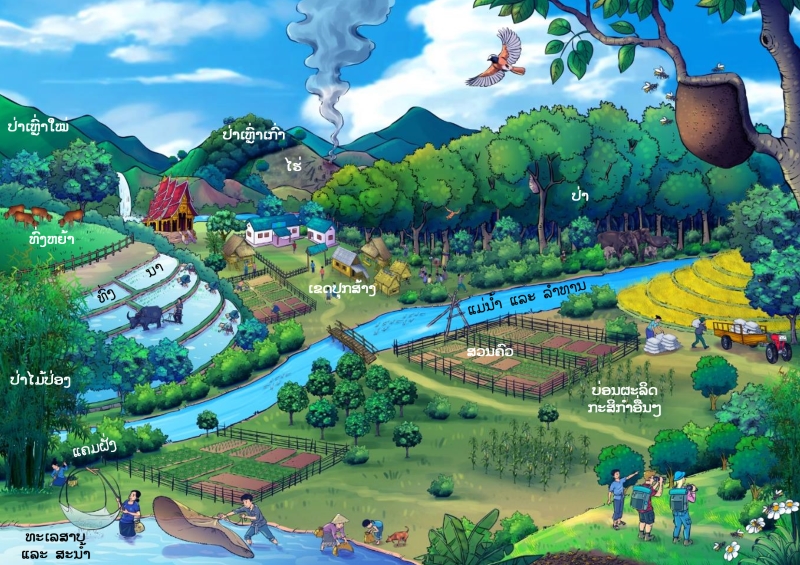
ສະເພາະຖິ່ນໃນລາວ:
ພື້ນເມືອງ
ຮຸກຮານ
:
ບໍ່ຮຸກຮານ
ສະຖານະພາບການອະນູຮັກ IUCN
:
ບໍ່ມີຄວາມສ່ຽງ
ສະຖານະພາບການອະນຸຮັກແຫ່ງຊາດລາວ
:
ບໍ່ຖືກລະບຸໃນບັນຊີປະເພດໃດ
ການນຳໃຊ້
ປະເພດການນຳໃຊ້:
ກິດຈະກຳການກະເສດ
ອາຫານ
ເຄື່ອງດື່ມ
ພືດເປັນຢາ
ເຄື່ອງສຳອາງ
ອາຫານ
ເຄື່ອງດື່ມ
ພືດເປັນຢາ
ເຄື່ອງສຳອາງ
ບັນຍາຍການນຳໃຊ້:
ອາຫານ: ແກ່ນຖົ່ວຂຽວນິຍົມນຳມາປະກອບເປັນອາຫານໄດ້ທັງຄາວ ແລະ ຫວານເຊັ່ນ: ຍຳຖົ່ວຂຽວ, ຖົ່ວຂຽວຕົ້ມ, ນ້ຳຫວານຖົ່ວຂຽວ, ແລະ ແກ່ນໃກ້ສຸກນໍາມາຕົ້ມໃສ່ເກືອ. ນອກນັ້ນ, ແກ່ນຖົ່ວຂຽວຍັງຍັງສາມາດນໍາໃຊ້ປະໂຫຍດ ແລະ ສາມາດແປຮູບໄດ້ຫຼາຍຢ່າງ ເຊັ່ນ: ປູກເປັນຖົ່ວງອກ, ເຮັດແປ້ງ ແລະ ເສັ້ນເຝີໄດ້. [8]
ເຄື່ອງດື່ມ: ຖົ່ວຂຽວສາມາດນຳມາເຮັດເປັນເຄື່ອງດື່ມໄດ້ເຊັ່ນ ນົມຖົ່ວຂຽວ [8].
ຢາ: ສານສະກັດຈາກຖົ່ວຂຽວມີປະໂຫຍດກ່ຽວຫຼາຍຕໍ່ກັບສຸຂະພາບ ເຊັ່ນ ຫຼຸດນ້ຳຕານໃນເລືອດ, ຫຼຸດໄຂມັນໃນເລືອດ, ຫຼຸດຄວາມດັນເລືອດສູງ, ຕ້ານມິເຮັງ, ຫຼຸດການສ້າງເມັດເມລານີນ, ປ້ອງກັນໂຣກຕັບ ແລະ ປັບພຸມຄຸ້ມກັນ [9]. ຖົ່ວຂຽວຍັງອຸດົມໄປດ້ວຍທາດ ແຄໂຣທີນ ເຊິ່ງຊ່ວຍປ້ອງກັນການເຊື່ອມຂອງດວງຕາ ແລະ ຊ່ວຍຜ່ອນດວງຕາເມື່ອເຮັດວຽກໜັກ [10].
ເຄື່ອງສຳອາງ: ຖົ່ວຂຽວໃຊ້ເຂົ້າໃນອຸດສາຫະກຳເຄື່ອງສຳອາງ [11]. ເປັນສານເຕີ່ມແຕ່ງໃນແປ້ງທີ່ຊ່ວຍສະລໍໄວ ແລະ ມາກໜ້າ ເນື່ອງຈາກຖົ່ງຂຽວມີສານຊ່ວຍປ້ອງສະລໍໄວ.[12]
ການປູກເປັນຟາມ: ຖົ່ວຂຽວເປັນພືດທີ່ມີປະໂຫຍດຫຼາກຫຼາຍ, ຝັກຖົ່ວຂຽວ ແລະ ແກ່ນສາມາດນຳໃຊ້ເປັນອາຫານສັດ ທີ່ມີຄຸນຄ່າທາງດ້ານໂພຊະນາການສູງກ່ວາຫຍ້າ. ເສດສ່ວນຂອງລຳຕົ້ນ ແລະ ເປືອກສາມາດໄຖ່ຖົ່ມລົງດິນເພື່ອເປັນປຸ໋ຍບຳລຸງດິນ [8].
ເຄື່ອງດື່ມ: ຖົ່ວຂຽວສາມາດນຳມາເຮັດເປັນເຄື່ອງດື່ມໄດ້ເຊັ່ນ ນົມຖົ່ວຂຽວ [8].
ຢາ: ສານສະກັດຈາກຖົ່ວຂຽວມີປະໂຫຍດກ່ຽວຫຼາຍຕໍ່ກັບສຸຂະພາບ ເຊັ່ນ ຫຼຸດນ້ຳຕານໃນເລືອດ, ຫຼຸດໄຂມັນໃນເລືອດ, ຫຼຸດຄວາມດັນເລືອດສູງ, ຕ້ານມິເຮັງ, ຫຼຸດການສ້າງເມັດເມລານີນ, ປ້ອງກັນໂຣກຕັບ ແລະ ປັບພຸມຄຸ້ມກັນ [9]. ຖົ່ວຂຽວຍັງອຸດົມໄປດ້ວຍທາດ ແຄໂຣທີນ ເຊິ່ງຊ່ວຍປ້ອງກັນການເຊື່ອມຂອງດວງຕາ ແລະ ຊ່ວຍຜ່ອນດວງຕາເມື່ອເຮັດວຽກໜັກ [10].
ເຄື່ອງສຳອາງ: ຖົ່ວຂຽວໃຊ້ເຂົ້າໃນອຸດສາຫະກຳເຄື່ອງສຳອາງ [11]. ເປັນສານເຕີ່ມແຕ່ງໃນແປ້ງທີ່ຊ່ວຍສະລໍໄວ ແລະ ມາກໜ້າ ເນື່ອງຈາກຖົ່ງຂຽວມີສານຊ່ວຍປ້ອງສະລໍໄວ.[12]
ການປູກເປັນຟາມ: ຖົ່ວຂຽວເປັນພືດທີ່ມີປະໂຫຍດຫຼາກຫຼາຍ, ຝັກຖົ່ວຂຽວ ແລະ ແກ່ນສາມາດນຳໃຊ້ເປັນອາຫານສັດ ທີ່ມີຄຸນຄ່າທາງດ້ານໂພຊະນາການສູງກ່ວາຫຍ້າ. ເສດສ່ວນຂອງລຳຕົ້ນ ແລະ ເປືອກສາມາດໄຖ່ຖົ່ມລົງດິນເພື່ອເປັນປຸ໋ຍບຳລຸງດິນ [8].
ການປູກ ການລ້ຽງ:
ຊະນິດປູກ
ລະດູການເກັບກູ້:
ກໍລະກົດ
ສິງຫາ
ກັນຍາ
ຕຸລາ
ພະຈິກ
ທັນວາ
ສິງຫາ
ກັນຍາ
ຕຸລາ
ພະຈິກ
ທັນວາ
ການຕະຫຼາດ ແລະ ຕ່ອງໂສ້ມູນຄ່າ:
ຖົ່ວຂຽວສົດມີວາງຂາຍຢູ່ຕະຫຼາດທົ່ວປະເທດລາວ, ນອກນີ້ຍັງມີຜະລິດຕະພັນຖົ່ວຂຽວແປຮູບ ແລະ ຖົ່ວຂຽວອົບແຫ້ງມີຂາຍເປັນຈຳນວນຫຼາຍພາຍໃນປະເທດ ແລະ ຕ່າງປະເທດ [7]
ການຄຸ້ມຄອງຈັດການ
ສະພາບໂດຍລວມ:
ດິນ: ຖົ່ວຂຽວສາມາດປູກໄດ້ໃນດິນເກືອບທຸກປະເພດ ແຕ່ດິນທີ່ເໝາະສົມທີ່ສຸດສຳລັບການຈະເລີນເຕີບໂຕຂອງຖົ່ວຂຽວຄືດິນພຸຜຸ່ຍທີ່ລະບາຍນ້ຳໄດ້ດີ, ມີຄວາມອຸດົມສົມບູນສູງ, ສາມາດກັກເກັບສານອາຫານໄດ້ດີ ແລະ ມີຄ່າ pH ຢູ່ລະຫວ່າງ 6.5 ຫາ 7.5. ຖົ່ວຂຽວບໍ່ມັກດິນທີ່ເປັນກົດ ຫຼື ດ່າງເຂັ້ມ.
ອຸນຫະພູມ: ຖົ່ວຂຽວສາມາດປູກໄດ້ໃນອຸ່ນຫະພູມສູງ ແຕ່ຖ້າອຸ່ນຫະພູມຕ່ຳກ່ວາ 20 ອົງສາ ຈະເຮັດໃຫ້ຖົ່ວຂຽວຈະເລີນເຕີບໂຕຊ້າ, ຖ້າອຸ່ນຫະພູມຕໍ່າກ່ວາ 10 ອົງສາ ຖົ່ວຂຽວຈະຢຸດການຈະເລີນເຕີບໂຕ ແລະ ສ່ວນຍອດອາດຈະຕາຍໄດ້.
ແຫຼ່ງທີ່ມາ: [14], [15]
ການຄັດເລືອກສາຍພັນ:
ແນວພັນຕ້ອງມາຈາກແຫຼ່ງທີ່ເຊື່ອຖືໄດ້ ຫຼື ໄດ້ຮັບການຮອງຮັບຈາກກະຊວງກະຊິກຳ, ແກ່ນພັນຕ້ອງສົມບູນ ປາສາຈາກຄວາມເສຍຫາຍຈາກພະຍາດ ແລະ ແມງໄມ້, ແລະ ມີອັດຕາການງອກຫຼາຍກ່າ 80%. [15]
ການກຽມພື້ນທີ່:
ການກຽມດິນເພື່ອປູກຖົ່ວຂຽວກໍຄືກັບການກຽມດິນເພື່ອປູກພືດຊະນິດອື່ນ, ກ່ອນອື່ນແມ່ນໃຫ້ກຳຈັດວັດສະພືດ ແລະ ເຟືອງອອກໃຫ້ໝົດ ຈາກນັ້ນຈຶ່ງປູກແນວພັນ, ຖ້າເປັນໄປໄດ້ໃຫ້ໄຖ່ດິນກ່ອນ. [7] [14], [15]
ເທັກນິກການປູກ:
ກ່ອນປູກໃຫ້ປະສົມແກ່ນຖົ່ວຂຽວກັບໄຣໂຊບ້ຽມ ເຊິ່ງເປັນເບັກທິເຣຍຊະນິດໜຶ່ງທີ່ຊ່ວຍໃຫ້ຖົ່ວສາມາດດຶງໄນໂຕເຈນຈາກອາກາດ ວິທີນີ້ຈະເຮັດໃຫ້ດິນມີຄວາມອຸດົມສົມບູນຫຼາຍຂື້ນ ແລະ ເພີ່ມຜົນຜະລິດໃຫ້ຫຼາຍຂື້ນ. [14], [15].
ການປູກ: ມີ 2 ວິທີຄື: ການຫວານເປັນວິທີ່ທີ່ເໝາະສົມສຳຫຼັລພື້ນທີ່ທີ່ມີການໄຖ່ດິນ, ໂດຍເຮົາຈະຫວານແກ່ນຖົ່ວຂຽວໃຫ້ທົ່ວ ຈາກນັ້ນແມ່ນໄຖດິນຖົ່ມບາງໆ ເພື່ອຄຸມແກ່ນ ແລະ ຮັກສາຄວາມຊຸ່ມໃນດິນ, ວິທີ່ນີ້ຈະເຮັດໃຫ້ແກ່ນງອກໄດ້ດີ ແບໍຄ່ອຍນິຍົມປູກເພາະແກ່ນຈະກະຈາຍຢູ່ທົ່ວ ແລະ ດູແລຮັກສາຍາກ. ສ່ວນການປູກເປັນແຖວ ຈະໃຊ້ໄມ້ປັກລົງດິນໃຫ້ເປັນຂຸມ ແລະ ຍອດແກ່ນຖົ່ວລົງຂຸມລະ 3-4 ແກ່ນ, ໄລຍະຫ່າງລະຫວ່າງຂຸມປະມານ 20 x 40 ຊມ. ຖ້າເປູກເປັນສຸ່ມ, ແຕ່ຖ້າປູກເປັນແຖວໄລຍະຫ່າງລະຫວ່າງແຖວປະມານ 20 x50 ຊມ. [7] [14], [15]
ການເບິ່ງແຍງ ແລະ ບຳລຸງຮັກສາ:
ການປູກຊ້ອມ ແລະ ການແຍກຕົ້ນອ່ອນ: ຫຼັງຈາກປູກໄດ້ 7- 10 ວັນ, ຫາກມີຂຸມຖົ່ວບໍ່ອອກ ຫຼື ອອກບໍ່ສະໝ່ຳສະເໝີໃຫ້ປູກຊ້ອມ, ຫາກຂຸມໃດມີຕົ້ນຖົ່ວທີ່ອອກຫຼາຍເກີນໄປ ໃຫ້ຖອນຕົ້ນທີມີຂະໜາດນ້ອຍ ແລະ ບໍ່ສົມບູນອອກ ແຕ່ລະວັງບໍ່ໃຫ້ຕົ້ນທີ່ເຫຼືອເກີດຄວາມເສຍຫາຍ.
ການໃສ່ປຸ໋ຍ: ໃນທ້ອງຖິ່ນສ່ວນໃຫຍ່ຖົ່ວຂຽວບໍ່ຈຳເປັນຕ້ອງໄດ້ໃສ່ປຸ໋ຍ.
ການໃຫ້ນ້ຳ: ຖົ່ວຂຽວມີຮາກຕື້ນ ເພາະສະນັ້ນຈຶ່ງຕ້ອງການນ້ຳຫຼາຍ ໂດຍສະເພາະໃນລະດູແລງຄວນໃຫ້ນ້ຳຖົ່ວຂຽວທັນທີຫຼັງປູກ ຫຼັງຈາກນັ້ນໃຫ້ພາຍາຍາມກວດສອບດິນຕະຫຼອດເພື່ອເບິ່ງຄວາມຊຸ່ມຂອງດິນວ່າຕ້ອງການນ້ຳ ຫຼື ບໍ່, ໂດຍທົ່ວໄປຄວນໃຫ້ນ້ຳປະມານ 3-4 ຄັ້ງ ໃນຊ່ວງລະດູການຈະເລີນເຕີບໂຕຂອງຖົ່ວ.
ການກຳຈັດວັດສະພືດ: ສາມາດກຳຈັດວັດສະພືດດ້ວຍມື ຫຼື ເຄື່ອງຈັກກໍໄດ້ຫາກມີພື້ນທີ່ປູກຈຳນວນຫຼາຍ, ເຖິ່ງຢ່າງໃດກໍຕາມຍ່າກຳຈັດວັດສະພືດເມື່ອ ຖົ່ວຂຽວກຳລັງອອກດອກ ແລະ ຕິດຝັກ ເພາະຈະເຮັດໃຫ້ຕົ້ນຖົ່ວຂຽວເກີດຄວາມເສຍຫາຍ.
ແຫຼ່ງທີ່ມາ: [7], [14], [15]
ການປົກປ້ອງ ແລະ ການກຳຈັດສັດຕູພືດ:
ດ້ວງກິນໃບ: ເພື່ອຄວບຄຸມດ້ວງກິນໃບໃຫ້ສີດພົ່ນນນຳຕົ້ມຈາກໃບກະເດົາປະສົມກັບນ້ຳໃນອັດຕາສ່ວນ 1:10 ໂດຍຈະສີດທຸກໆ 7 ວັນ
ໜອນ: ຄວນຫົດນ້ຳຕົ້ນໄມ້ປະຈຳເພື່ອຊ່ວຍຫຼຸດຈຳນວນໜອນທີ່ຍັງນ້ອຍໄດ້
ກະເບື້ອກາງຄືນ: ເພື່ອປ້ອງກັນແກ່ນຖົ່ວຈາກກະເບື້ອກາງຄືນ ຄວນຕາກແກ່ນໃຫ້ແຫ້ງໃຫ້ໄດ້ຄວາມຊຸ່ມປະມານ 12%, ຈາກນັ້ນ ປະສົມນ້ຳມັນພືດທີ່ສະກັດຈາກແກ່ນຖົ່ວ ແລະ ຮຳເຂົ້າໃນອັດຕາ 5 ມລ/1 ກິໂລກຣາມ, ນີ້ຈະປົກປ້ອງເມັດສໍາລັບ 5-7 ເດືອນ. ນອກນັ້ນທ່ານຍັງສາມາດເກັບກ່ຽວໄດ້ດ້ວຍວິທີດັ້ງເດີມ ໂດຍການຫວ່ານຂີ້ເຖົ່າໃສ່ [4]
ການເກັບກ່ຽວ:
ຖົ່ວຂຽວບໍ່ໄດ້ເກັບກ່ຽວຄັ້ງດຽວທັງໝົດເທື່ອດຽວ ເມື່ອສັງເກດເຫັນວ່າຝັກຖົ່ວສຸກປະມານ 60-80% ກໍ່ສາມາດເກັບໄດ້. ນຳເອົາຝັກໄປຕາກແດດໃຫ້ແຫ້ງປະມານ 2-3 ມື້ ແລ້ວໃຊ້ໄມ້ຕີເບົາໆເພື່ອຕີເອົາແກ່ນອອກ, ຖ້າມີຈຳນວນຫຼາຍສາມາດນໍາໃຊ້ເຄື່ອງຂະຫນາດນ້ອຍໄດ້. [7]
ກ່ອນເກັບຮັກສາແກ່ນ ຄວນເຮັດໃຫ້ແຫ້ງກ່ອນເພື່ອຫຼຸດຄວາມຊຸ່ມ ຖ້າບໍ່ດັງນັ້ນຖົ່ວຂຽວອາດຈະເສຍຫາຍໄດ້ງ່າຍຈາກເຊື້ອຣາ ແລະ ຮາດຳ. [7]
ຄວາມຍືນຍົງ:
ເນື່ອງຈາກຖົ່ວຂຽວເປັນພືດຕະກຸນຖົ່ວທີ່ສາມາດດຶງໄນໂຕເຈນ (N) ຈາກອາກາດໄດ້ດ້ວຍຕົວເອງ ເຮັດໃຫ້ດິນມີຄວາມອຸດົມສົມບູນ ແລະ ຊຸ່ມ.[16]
ດິນ: ຖົ່ວຂຽວສາມາດປູກໄດ້ໃນດິນເກືອບທຸກປະເພດ ແຕ່ດິນທີ່ເໝາະສົມທີ່ສຸດສຳລັບການຈະເລີນເຕີບໂຕຂອງຖົ່ວຂຽວຄືດິນພຸຜຸ່ຍທີ່ລະບາຍນ້ຳໄດ້ດີ, ມີຄວາມອຸດົມສົມບູນສູງ, ສາມາດກັກເກັບສານອາຫານໄດ້ດີ ແລະ ມີຄ່າ pH ຢູ່ລະຫວ່າງ 6.5 ຫາ 7.5. ຖົ່ວຂຽວບໍ່ມັກດິນທີ່ເປັນກົດ ຫຼື ດ່າງເຂັ້ມ.
ອຸນຫະພູມ: ຖົ່ວຂຽວສາມາດປູກໄດ້ໃນອຸ່ນຫະພູມສູງ ແຕ່ຖ້າອຸ່ນຫະພູມຕ່ຳກ່ວາ 20 ອົງສາ ຈະເຮັດໃຫ້ຖົ່ວຂຽວຈະເລີນເຕີບໂຕຊ້າ, ຖ້າອຸ່ນຫະພູມຕໍ່າກ່ວາ 10 ອົງສາ ຖົ່ວຂຽວຈະຢຸດການຈະເລີນເຕີບໂຕ ແລະ ສ່ວນຍອດອາດຈະຕາຍໄດ້.
ແຫຼ່ງທີ່ມາ: [14], [15]
ການຄັດເລືອກສາຍພັນ:
ແນວພັນຕ້ອງມາຈາກແຫຼ່ງທີ່ເຊື່ອຖືໄດ້ ຫຼື ໄດ້ຮັບການຮອງຮັບຈາກກະຊວງກະຊິກຳ, ແກ່ນພັນຕ້ອງສົມບູນ ປາສາຈາກຄວາມເສຍຫາຍຈາກພະຍາດ ແລະ ແມງໄມ້, ແລະ ມີອັດຕາການງອກຫຼາຍກ່າ 80%. [15]
ການກຽມພື້ນທີ່:
ການກຽມດິນເພື່ອປູກຖົ່ວຂຽວກໍຄືກັບການກຽມດິນເພື່ອປູກພືດຊະນິດອື່ນ, ກ່ອນອື່ນແມ່ນໃຫ້ກຳຈັດວັດສະພືດ ແລະ ເຟືອງອອກໃຫ້ໝົດ ຈາກນັ້ນຈຶ່ງປູກແນວພັນ, ຖ້າເປັນໄປໄດ້ໃຫ້ໄຖ່ດິນກ່ອນ. [7] [14], [15]
ເທັກນິກການປູກ:
ກ່ອນປູກໃຫ້ປະສົມແກ່ນຖົ່ວຂຽວກັບໄຣໂຊບ້ຽມ ເຊິ່ງເປັນເບັກທິເຣຍຊະນິດໜຶ່ງທີ່ຊ່ວຍໃຫ້ຖົ່ວສາມາດດຶງໄນໂຕເຈນຈາກອາກາດ ວິທີນີ້ຈະເຮັດໃຫ້ດິນມີຄວາມອຸດົມສົມບູນຫຼາຍຂື້ນ ແລະ ເພີ່ມຜົນຜະລິດໃຫ້ຫຼາຍຂື້ນ. [14], [15].
ການປູກ: ມີ 2 ວິທີຄື: ການຫວານເປັນວິທີ່ທີ່ເໝາະສົມສຳຫຼັລພື້ນທີ່ທີ່ມີການໄຖ່ດິນ, ໂດຍເຮົາຈະຫວານແກ່ນຖົ່ວຂຽວໃຫ້ທົ່ວ ຈາກນັ້ນແມ່ນໄຖດິນຖົ່ມບາງໆ ເພື່ອຄຸມແກ່ນ ແລະ ຮັກສາຄວາມຊຸ່ມໃນດິນ, ວິທີ່ນີ້ຈະເຮັດໃຫ້ແກ່ນງອກໄດ້ດີ ແບໍຄ່ອຍນິຍົມປູກເພາະແກ່ນຈະກະຈາຍຢູ່ທົ່ວ ແລະ ດູແລຮັກສາຍາກ. ສ່ວນການປູກເປັນແຖວ ຈະໃຊ້ໄມ້ປັກລົງດິນໃຫ້ເປັນຂຸມ ແລະ ຍອດແກ່ນຖົ່ວລົງຂຸມລະ 3-4 ແກ່ນ, ໄລຍະຫ່າງລະຫວ່າງຂຸມປະມານ 20 x 40 ຊມ. ຖ້າເປູກເປັນສຸ່ມ, ແຕ່ຖ້າປູກເປັນແຖວໄລຍະຫ່າງລະຫວ່າງແຖວປະມານ 20 x50 ຊມ. [7] [14], [15]
ການເບິ່ງແຍງ ແລະ ບຳລຸງຮັກສາ:
ການປູກຊ້ອມ ແລະ ການແຍກຕົ້ນອ່ອນ: ຫຼັງຈາກປູກໄດ້ 7- 10 ວັນ, ຫາກມີຂຸມຖົ່ວບໍ່ອອກ ຫຼື ອອກບໍ່ສະໝ່ຳສະເໝີໃຫ້ປູກຊ້ອມ, ຫາກຂຸມໃດມີຕົ້ນຖົ່ວທີ່ອອກຫຼາຍເກີນໄປ ໃຫ້ຖອນຕົ້ນທີມີຂະໜາດນ້ອຍ ແລະ ບໍ່ສົມບູນອອກ ແຕ່ລະວັງບໍ່ໃຫ້ຕົ້ນທີ່ເຫຼືອເກີດຄວາມເສຍຫາຍ.
ການໃສ່ປຸ໋ຍ: ໃນທ້ອງຖິ່ນສ່ວນໃຫຍ່ຖົ່ວຂຽວບໍ່ຈຳເປັນຕ້ອງໄດ້ໃສ່ປຸ໋ຍ.
ການໃຫ້ນ້ຳ: ຖົ່ວຂຽວມີຮາກຕື້ນ ເພາະສະນັ້ນຈຶ່ງຕ້ອງການນ້ຳຫຼາຍ ໂດຍສະເພາະໃນລະດູແລງຄວນໃຫ້ນ້ຳຖົ່ວຂຽວທັນທີຫຼັງປູກ ຫຼັງຈາກນັ້ນໃຫ້ພາຍາຍາມກວດສອບດິນຕະຫຼອດເພື່ອເບິ່ງຄວາມຊຸ່ມຂອງດິນວ່າຕ້ອງການນ້ຳ ຫຼື ບໍ່, ໂດຍທົ່ວໄປຄວນໃຫ້ນ້ຳປະມານ 3-4 ຄັ້ງ ໃນຊ່ວງລະດູການຈະເລີນເຕີບໂຕຂອງຖົ່ວ.
ການກຳຈັດວັດສະພືດ: ສາມາດກຳຈັດວັດສະພືດດ້ວຍມື ຫຼື ເຄື່ອງຈັກກໍໄດ້ຫາກມີພື້ນທີ່ປູກຈຳນວນຫຼາຍ, ເຖິ່ງຢ່າງໃດກໍຕາມຍ່າກຳຈັດວັດສະພືດເມື່ອ ຖົ່ວຂຽວກຳລັງອອກດອກ ແລະ ຕິດຝັກ ເພາະຈະເຮັດໃຫ້ຕົ້ນຖົ່ວຂຽວເກີດຄວາມເສຍຫາຍ.
ແຫຼ່ງທີ່ມາ: [7], [14], [15]
ການປົກປ້ອງ ແລະ ການກຳຈັດສັດຕູພືດ:
ດ້ວງກິນໃບ: ເພື່ອຄວບຄຸມດ້ວງກິນໃບໃຫ້ສີດພົ່ນນນຳຕົ້ມຈາກໃບກະເດົາປະສົມກັບນ້ຳໃນອັດຕາສ່ວນ 1:10 ໂດຍຈະສີດທຸກໆ 7 ວັນ
ໜອນ: ຄວນຫົດນ້ຳຕົ້ນໄມ້ປະຈຳເພື່ອຊ່ວຍຫຼຸດຈຳນວນໜອນທີ່ຍັງນ້ອຍໄດ້
ກະເບື້ອກາງຄືນ: ເພື່ອປ້ອງກັນແກ່ນຖົ່ວຈາກກະເບື້ອກາງຄືນ ຄວນຕາກແກ່ນໃຫ້ແຫ້ງໃຫ້ໄດ້ຄວາມຊຸ່ມປະມານ 12%, ຈາກນັ້ນ ປະສົມນ້ຳມັນພືດທີ່ສະກັດຈາກແກ່ນຖົ່ວ ແລະ ຮຳເຂົ້າໃນອັດຕາ 5 ມລ/1 ກິໂລກຣາມ, ນີ້ຈະປົກປ້ອງເມັດສໍາລັບ 5-7 ເດືອນ. ນອກນັ້ນທ່ານຍັງສາມາດເກັບກ່ຽວໄດ້ດ້ວຍວິທີດັ້ງເດີມ ໂດຍການຫວ່ານຂີ້ເຖົ່າໃສ່ [4]
ການເກັບກ່ຽວ:
ຖົ່ວຂຽວບໍ່ໄດ້ເກັບກ່ຽວຄັ້ງດຽວທັງໝົດເທື່ອດຽວ ເມື່ອສັງເກດເຫັນວ່າຝັກຖົ່ວສຸກປະມານ 60-80% ກໍ່ສາມາດເກັບໄດ້. ນຳເອົາຝັກໄປຕາກແດດໃຫ້ແຫ້ງປະມານ 2-3 ມື້ ແລ້ວໃຊ້ໄມ້ຕີເບົາໆເພື່ອຕີເອົາແກ່ນອອກ, ຖ້າມີຈຳນວນຫຼາຍສາມາດນໍາໃຊ້ເຄື່ອງຂະຫນາດນ້ອຍໄດ້. [7]
ກ່ອນເກັບຮັກສາແກ່ນ ຄວນເຮັດໃຫ້ແຫ້ງກ່ອນເພື່ອຫຼຸດຄວາມຊຸ່ມ ຖ້າບໍ່ດັງນັ້ນຖົ່ວຂຽວອາດຈະເສຍຫາຍໄດ້ງ່າຍຈາກເຊື້ອຣາ ແລະ ຮາດຳ. [7]
ຄວາມຍືນຍົງ:
ເນື່ອງຈາກຖົ່ວຂຽວເປັນພືດຕະກຸນຖົ່ວທີ່ສາມາດດຶງໄນໂຕເຈນ (N) ຈາກອາກາດໄດ້ດ້ວຍຕົວເອງ ເຮັດໃຫ້ດິນມີຄວາມອຸດົມສົມບູນ ແລະ ຊຸ່ມ.[16]
ໂພຊະນາການ
ຄຸນຄ່າທາງໂພຊະນາການ:
ແຫຼ່ງໂປຣຕີນທີ່ສຳຄັນ
ແຫຼ່ງຄາໂບໄຮເດຣດທີ່ສຳຄັນ
ແຫຼ່ງຄາໂບໄຮເດຣດທີ່ສຳຄັນ
ບັນຍາຍຄຸນຄ່າທາງໂພຊະນາການ:
ຖົ່ວຂຽວເປັນແຫຼ່ງໂປຣຕີນ ແລະ ຄາໂບໄຮເດດທີ່ມີປະໂຫຍດ. [13]
| ສານອາຫານ | /100g | ໝາຍເຫດ |
|---|---|---|
| ໂປຣຕີນ | 23.2 | N/A |
| ຄາໂບໄຮເດຣດ | 34.7 | N/A |
| ໄຂມັນ | 1.9 | N/A |
| ວິຕາມິນ | N/A | ວິຕາມິນ A 14 (RAE mcg), ວິຕາມິນ B1 0.73 (mg), ວິຕາມິນ B2 0.26 (mg), ວິຕາມິນ B3 2.5 (mg), ວິຕາມິນ C 2 (mg) |
| ແຮ່ທາດ | N/A | ແຄລຊ້ຽມ 97 (mg), ນ້ຳ 10.6 (g), ໂພແທັກຊ້ຽມ 863 (mg), ໂຊດຽມ 44 (mg), ທາດເຫຼັກ 5.6 (mg), ສັງກະສີ 2.7 (mg), ຟົດສຟໍຣັສ 349 (mg), ທອງແດງ 1.4 (mg), ໂຊດ້ຽມ 44 (mg), ແຄລໂຣທີນ 165 (mcg) |
| ເສັ້ນໄຍ | 26.1 | N/A |
ອ້າງອິງ
ເຄດິດຮູບພາບ:
Leave. [1] iNaturalist [Online]. Uploaded on 7 November 2022 by: Chuangzao. Available: https://www.inaturalist.org/observations/141327928. [Accessed: 30 September]
Flower. [2] iNaturalist [Online]. Uploaded on 9 July 2023 by: smalltown huang. Available: https://www.inaturalist.org/observations/171914323. [Accessed: 30 September]
Fruit. [3] iNaturalist [Online]. Uploaded on 8 March 2023 by: Radha Veach. Available: https://www.inaturalist.org/observations/150528112. [Accessed: 30 September]
Seed. [4] "Mung beans (Vigna radiata)," *Wikipedia*, [Online]. Available:
https://en.wikipedia.org/wiki/Mung_bean#/media/File:Mung_beans_(Vigna_radiata).jpg. [Accessed: Sep. 30, 2024].
Flower. [2] iNaturalist [Online]. Uploaded on 9 July 2023 by: smalltown huang. Available: https://www.inaturalist.org/observations/171914323. [Accessed: 30 September]
Fruit. [3] iNaturalist [Online]. Uploaded on 8 March 2023 by: Radha Veach. Available: https://www.inaturalist.org/observations/150528112. [Accessed: 30 September]
Seed. [4] "Mung beans (Vigna radiata)," *Wikipedia*, [Online]. Available:
https://en.wikipedia.org/wiki/Mung_bean#/media/File:Mung_beans_(Vigna_radiata).jpg. [Accessed: Sep. 30, 2024].
ອ້າງອິງ:
[5] Prabhavat, S., Titathan, Y., Hengswadi, D., Auttaviboonkul, P. 1998. Study on the Production of Cookies from Black Gram Compare with Cookies from Mungbean and Pigeon Pea. Kasetsart J. (Nat. Sci.) 32: 319 – 328.
[6] "Ipheion uniflorum (Graham) Raf.," *Plants of the World Online*, Kew Science, [Online]. Available: https://powo.science.kew.org/taxon/urn:lsid:ipni.org:names:525492-1#source-KBD. [Accessed: Sep. 30, 2024].
[7] ກະຊວງກະສິກຳ ແລະ ປ່າໄມ້. (2000) ເອກະສານປະກອບການຮຽນການສອນ ວິຊາ ການປູກພືດເສກຖະກິດ. ຫຼັກສູດສຳລັບໂຮງຮຽນກະສິກຳ ແລະ ປ່າໄມ້ຊັ້ນກາງ.
[8] "ถั่วเขียว," *MedThai*, [Online]. Available: https://medthai.com/%E0%B8%96%E0%B8%B1%E0%B9%88%E0%B8%A7%E0%B9%80%E0%B8%82%E0%B8%B5%E0%B8%A2%E0%B8%A7/. [Accessed: Sep. 30, 2024].
[9] Hou, D., Yousaf, L., Xue, Y., Hu, J., Wu, J., Hu, X., Feng, N., Shen, Q. 2019. Mung Bean (Vigna radiata L.): Bioactive Polyphenols, Polysaccharides, Peptides, and Health Benefits. Nutrients (11): 1238.
[10] อนุสรณ์ โนล่า, "รายงานโปรเจคอนุสรณ์," *KMITL*, [ออนไลน์]. เข้าถึงได้: https://bitly.cx/3byn. [เข้าถึงเมื่อ: 30 ก.ย. 2024].
[11] Tiwari, U., Servan, A., Nigam, D. 2017. Comparative study on antioxidant activity, phytochemical analysis and mineral composition of the Mung Bean (Vigna Radiata) and its sprouts. Journal of Pharmacognosy and Phytochemistry, 6(1): 336-340.
[12] A. Author1, B. Author2, and C. Author3, "Title of the article," * MedlinePlus Health Information*, vol. 10, no. 2, pp. 123-130, Feb. 2015. https://pubmed.ncbi.nlm.nih.gov/25423740/.
[13] ສີວຽງແຂກ ພົມມະລາດ ແລະ ເນລະມິດ ບຸນບັນດິດ. (2014) ຄູ່ມືແນະນຳ ເຕັກນິກການຜະລິດຖົ່ວຂຽວ. ສະຖາບັນຄົ້ນຄ້ວາກະຊິກຳ, ປ່າໄມ້ ແລະ ພັດທະນາຊົນນະບົດ, ສູນຄົ້ນຄວ້າສາລີ ແລະ ພືດເສດຖະກິດ.
[14] ອາມອນທິບ ພິລົມບູນ ແລະ ອຳໄພພົງ ເກາະທຽນ. 2018. ການປູກ ຖົ່ວຂຽວໃນລະດູແລງ. ກະຊວງກະການກະເສດ ແລະ ສະຫະກອນ, ປະເທດໄທ. Website: https://pubhtml5.com/qton/fbqk/
[15] ສຸມນາ ງາມພ່ອງໃສ ແລະ ຄະນະ. 2019. ຄູ່ມືການຜະລິດແກ່ນພັນ ຖົ່ວຂຽວ. ສູນວິໄຈພືດໄຮ່ໄຊຍະນານ, ສະຖາບັນວິໄຈພືດໄຮ່ ແລະ ພືດທົດແທນພະລັງງານ, ກົມການກະເສດ, ກະຊວງກະເສດ ແລະ ສະຫະກອນ.
[16] J. Doe, "Mung Beans Help Diversify Cover Crop Mixes, Stretch Feed Supplies," *Cover Crop Strategies*, Jan. 2024. [Online]. Available: https://www.covercropstrategies.com/blogs/1-covering-cover-crops/post/1094-mung-beans-help-diversify-cover-crop-mixes-stretch-feed-supplies. [Accessed: Sep. 30, 2024].
[6] "Ipheion uniflorum (Graham) Raf.," *Plants of the World Online*, Kew Science, [Online]. Available: https://powo.science.kew.org/taxon/urn:lsid:ipni.org:names:525492-1#source-KBD. [Accessed: Sep. 30, 2024].
[7] ກະຊວງກະສິກຳ ແລະ ປ່າໄມ້. (2000) ເອກະສານປະກອບການຮຽນການສອນ ວິຊາ ການປູກພືດເສກຖະກິດ. ຫຼັກສູດສຳລັບໂຮງຮຽນກະສິກຳ ແລະ ປ່າໄມ້ຊັ້ນກາງ.
[8] "ถั่วเขียว," *MedThai*, [Online]. Available: https://medthai.com/%E0%B8%96%E0%B8%B1%E0%B9%88%E0%B8%A7%E0%B9%80%E0%B8%82%E0%B8%B5%E0%B8%A2%E0%B8%A7/. [Accessed: Sep. 30, 2024].
[9] Hou, D., Yousaf, L., Xue, Y., Hu, J., Wu, J., Hu, X., Feng, N., Shen, Q. 2019. Mung Bean (Vigna radiata L.): Bioactive Polyphenols, Polysaccharides, Peptides, and Health Benefits. Nutrients (11): 1238.
[10] อนุสรณ์ โนล่า, "รายงานโปรเจคอนุสรณ์," *KMITL*, [ออนไลน์]. เข้าถึงได้: https://bitly.cx/3byn. [เข้าถึงเมื่อ: 30 ก.ย. 2024].
[11] Tiwari, U., Servan, A., Nigam, D. 2017. Comparative study on antioxidant activity, phytochemical analysis and mineral composition of the Mung Bean (Vigna Radiata) and its sprouts. Journal of Pharmacognosy and Phytochemistry, 6(1): 336-340.
[12] A. Author1, B. Author2, and C. Author3, "Title of the article," * MedlinePlus Health Information*, vol. 10, no. 2, pp. 123-130, Feb. 2015. https://pubmed.ncbi.nlm.nih.gov/25423740/.
[13] ສີວຽງແຂກ ພົມມະລາດ ແລະ ເນລະມິດ ບຸນບັນດິດ. (2014) ຄູ່ມືແນະນຳ ເຕັກນິກການຜະລິດຖົ່ວຂຽວ. ສະຖາບັນຄົ້ນຄ້ວາກະຊິກຳ, ປ່າໄມ້ ແລະ ພັດທະນາຊົນນະບົດ, ສູນຄົ້ນຄວ້າສາລີ ແລະ ພືດເສດຖະກິດ.
[14] ອາມອນທິບ ພິລົມບູນ ແລະ ອຳໄພພົງ ເກາະທຽນ. 2018. ການປູກ ຖົ່ວຂຽວໃນລະດູແລງ. ກະຊວງກະການກະເສດ ແລະ ສະຫະກອນ, ປະເທດໄທ. Website: https://pubhtml5.com/qton/fbqk/
[15] ສຸມນາ ງາມພ່ອງໃສ ແລະ ຄະນະ. 2019. ຄູ່ມືການຜະລິດແກ່ນພັນ ຖົ່ວຂຽວ. ສູນວິໄຈພືດໄຮ່ໄຊຍະນານ, ສະຖາບັນວິໄຈພືດໄຮ່ ແລະ ພືດທົດແທນພະລັງງານ, ກົມການກະເສດ, ກະຊວງກະເສດ ແລະ ສະຫະກອນ.
[16] J. Doe, "Mung Beans Help Diversify Cover Crop Mixes, Stretch Feed Supplies," *Cover Crop Strategies*, Jan. 2024. [Online]. Available: https://www.covercropstrategies.com/blogs/1-covering-cover-crops/post/1094-mung-beans-help-diversify-cover-crop-mixes-stretch-feed-supplies. [Accessed: Sep. 30, 2024].
ຜູ້ສ້າງ Factsheet:
ຜູ້ກວດສອບ Factsheet:
,
